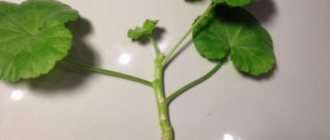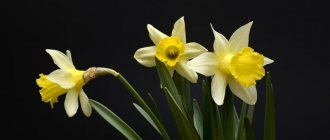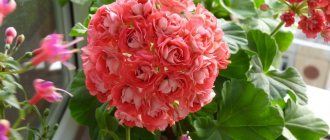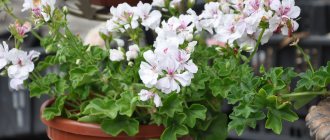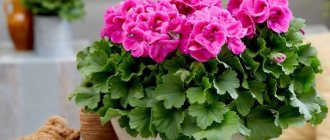Bright, lush flowering most of the year, a tart, bitter-floral aroma, unpretentiousness of the plant - thanks to these qualities, geranium has firmly become one of the most beloved indoor plants in the world. In today's review we will talk about the basic rules for caring for this flower at different times of the year, how to propagate and replant it correctly, as well as what diseases you may encounter and for what reasons.
Geranium flowers come in many colors
Origin of geranium
Geranium came to European windowsills in the 17th century, being brought to England by sailors from southern countries - Africa and India. In its historical homeland, this plant is a perennial and wild-growing plant; it is a subshrub with powerful shoots, smooth, slightly pubescent leaves and umbrella-shaped inflorescences. In the natural environment, geranium can also be found in Madagascar, Australia, New Zealand and California.
A beautiful and bright flower has another name: “crane bird”
Information: the geranium family has many faces, numbering up to 800 species. The name is of Greek origin. Geranios is translated as “crane” - due to the similarity of the plant’s fruits to the beak of this bird.
Geranium became a decoration for balconies thanks to the efforts of English breeders. Since the 17th century, they have worked tirelessly to develop new varieties and varieties of pelargonium, obtaining double and intricately shaped flowers of various shades, achieving stunning decorativeness and compactness from the plant.
At first, geranium was the privilege of the nobility. It could only be seen on the windows of nobles and on the hats of rich ladies. But as its popularity grew, the flower expanded the boundaries of its habitat, and ordinary people gradually began to breed it.
Botanical description and history
Pelargonium terry is an indoor (sometimes garden) plant that belongs to the Geraniaceae family. In the natural environment they are found in the form of subshrubs, and a little less often - shrubs. There are both annual and perennial varieties. Among these varieties there are also terry varieties, which in turn are also divided into subspecies:
- royal;
- zonal;
- ivy-shaped (ampeloid) and so on.
The variety received its name due to the special arrangement of petals - in one row there can be up to eight petals at the same time.
They all grow not side by side, but as if investing in each other. Due to this, the bud looks very lush. The birthplace of the described flower is considered to be South Africa, as well as India. The plant first appeared in European countries at the end of the 18th century. Residents of Europe immediately appreciated the plant and began planting them en masse in their flower beds and window sills. Over time, pelargonium was named a symbol of the Victorian era and became an attribute of comfort in every home.
Description of appearance, is it difficult to keep the flower indoors?
Geranium has a branched root system and dissected or lobed leaves. Their color depends on the type of plant and varies from dark green to grayish and reddish, sometimes with spectacular spots. Geranium flowers are predominantly large in size and can be red, white, violet, purple, orange, or variegated. Collected in racemose inflorescences, 1–3 on a peduncle or can be solitary.
The plant has healing properties; it treats diseases of all groups of organs.
Homemade geranium is not capricious and does not require care. Even a novice gardener can grow a beautiful plant and get it to bloom lushly. It is only important to follow a few basic rules of maintenance, remembering that the homeland of geraniums is warm countries.
- Geranium loves warmth, but not the scorching sun.
- It reacts equally poorly to drying out of the soil and to excessive watering.
- Sensitive to lack of sunlight. Loves southern window sills.
- Needs normal air humidity in the room - without extremes and away from hot heating radiators.
Types and varieties
Breeders have succeeded in transforming geraniums. Some of its varieties resemble the “source” only remotely. But in all the variety of shapes and colors, experts distinguish 6 main types.
Zonal
They are the most common. The name was given because of the colored halo on the leaves in the form of a ring-zone in the center.
The zonal species is represented by a large number of species and varieties. All zonal geraniums are divided into non-double, semi-double and double - according to the number of petals in the flower. The most lush, terry ones have more than 8 petals, non-double ones are limited to five.
The most common type of plant, includes 17 species
Also in the group of zonal pelargoniums there is a division into subgroups.
- Rosaceae - with flowers resembling roses.
- Tulip-shaped - similar to an unopened tulip bud.
- Carnation flowers - with carved petals of large flowers reminiscent of garden carnations.
- Star-shaped - with sharply shaped flowers and leaves resembling the edges of a star.
- Cactiformes are a rare subgroup of geraniums with elongated flower petals rolled into a tube.
- “Deacons” are geraniums characterized by their compact shape and abundant flowering. Flowers in pink, orange and red shades.
Fragrant
Depending on the type, scented geranium can exude 26 different scents
A group of geranium varieties bred for their scent. Outwardly, this species is unprepossessing - the flowers are small, inconspicuous, the bush is lanky, the leaves are inexpressive. But! Very fragrant, striking with a range of aromas - apple, pineapple, peach, grapefruit, wormwood, mint, rose, pine needles, verbena, oriental spices and herbs...
Ivy-leaved or ampelous
This species is bred to decorate balconies and loggias. Hanging shoots of ampelous pelargoniums look great in hanging flowerpots.
This type of plant is often used for hanging decoration of summer cottages and houses.
The second name - ivy-leaved - geranium received for its hard and dense leaves, as smooth as those of ivy.
Royal
The most striking and memorable subspecies of the plant
It lives up to its name with a powerful bush and large flowers - up to 7 cm in diameter. Of all the decorative species, this one is the most capricious to care for and has the shortest flowering period.
Uniques
One of the oldest types of geraniums, bred in the mid-18th century by crossing royal and brilliant pelargoniums. The presence of “royal blood” makes their flowers similar, only smaller in size.
Difficult to care for, but delightful-looking flower
Unicums are popular among garden gardeners. To bloom, this species needs to grow to 50 cm. Also, unique plants need pruning and pinching, so they bush themselves reluctantly.
Angels
They are often confused with royal geraniums, but this is wrong. “Angels” is a separate species, bred through crossing curly and royal pelargoniums and then undergoing a process of hybridization within its group.
A masterpiece of selection, “inherited” from its parents aroma, aesthetic appearance, growth rate
The flowers and leaves of the “angels” are smaller than the royal ones. The bushes do not grow vertically, but in an ampelous manner and are not as capricious in care as their royal relatives - they are more resistant to temperature changes, tolerate dry conditions better and grow faster.
Try other geranium varieties from a reputable supplier:


